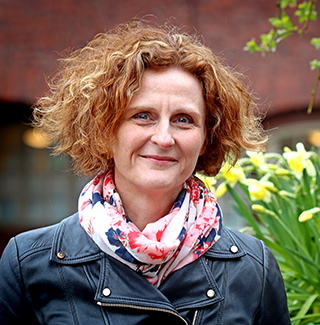Professor's tip: Discussion is the best route to lasting knowledge

Those who Google Hedvig Kjellström will soon realise that her educational work extends far beyond KTH's seminar halls and Zoom rooms. You'll find her in morning sofas and radio studios, confidently explaining artificial intelligence and much more. That confidence is also found in her teaching.
How do teachers meet their students in the best possible way? KTH professor Hedvig Kjellström has a solid answer to that question.
"By taking them seriously, having high expectations of them and letting them come into contact with current research and development early on. But also by setting reasonable requirements, and keeping in mind that the students are taking three or four courses in parallel and need to keep up with them all," Kjellström says.
Interpreting human and animal behaviour
She is currently teaching on the Technical Mathematics programme, where she teaches a course in basic computer science. Kjellström's research focuses on the big technology buzz of recent years, in other words, AI. Here she researches how computers can interpret human and animal behavior, and she has a number of interdisciplinary collaborations with doctors, veterinarians, psychologists and artists.
The road there, Kjellström's own academic career, has been multifaceted.
"I started studying Technical Physics at KTH because I found physics in upper secondary school very exciting. However, I quickly discovered that it was not physics that was the most fun, but I became more interested in maths and programming," Kjellström says.
Not even an email address
Programming was not something Kjellström had done before. Besides, the calendar said early 1990s, and at that time she did not even have an email address when she started her KTH studies. Her last course was about computer vision, how to get computers to interpret images.

"It was such a fun course that I started a PhD in this subject right after graduation. After a few fun years of exchanges in the US, I got my PhD and worked at the Swedish Defence Research Agency, FOI. Since 2007, I am back at KTH, now as a professor in computer vision. One of the subjects now included in the AI area," Kjellström says.
Bright future prospects
But what will students work with when they graduate from KTH? What are the future prospects in the AI field?
"They are bright. I can't really say what you will work with – the point of a civil engineering programme is that you learn theory and basics that allow you to shape how you work in the future, define new problems and methods and not just adapt to working with methods invented by others," Kjellström says
Why should one study at KTH?
"KTH is the largest technical university in Sweden and has a very broad and complete set of subjects and programmes. We are also at the forefront internationally and have many foreign students, teachers, researchers and exchanges. Quite simply, an exciting place," Kjellström says.
Hear mostly the negative
It is usually said that it takes ten positive comments to outweigh one bad one. Perhaps Kjellström can vouch for that. In response to the question of what kind of feedback she usually gets from students, she says that unfortunately she mostly hears the negative feedback.
"It's not so common for students to spontaneously say when they think something is good... But the negative is very good information too. It often gives ideas on how to improve the course for next year," Kjellström says.
Kjellström has brought some things from her own studies into her pedagogy. For example, the importance of attending lectures and actively participating in teaching.
"It's mostly voluntary attendance. It can be comfortable to just sit at home and study, especially if you got used to it during the pandemic, but the only way to learn in depth, and to see things from different perspectives, is to discuss with fellow students," Kjellström says.
Finally, perhaps most important of all: tell us about your most joyful moment as a teacher at KTH.
"There was a Polish exchange student who chose to go to KTH for a year just because of my course on how to design search engines. That was fun!," Kjellström says.
Text: Peter Asplund
